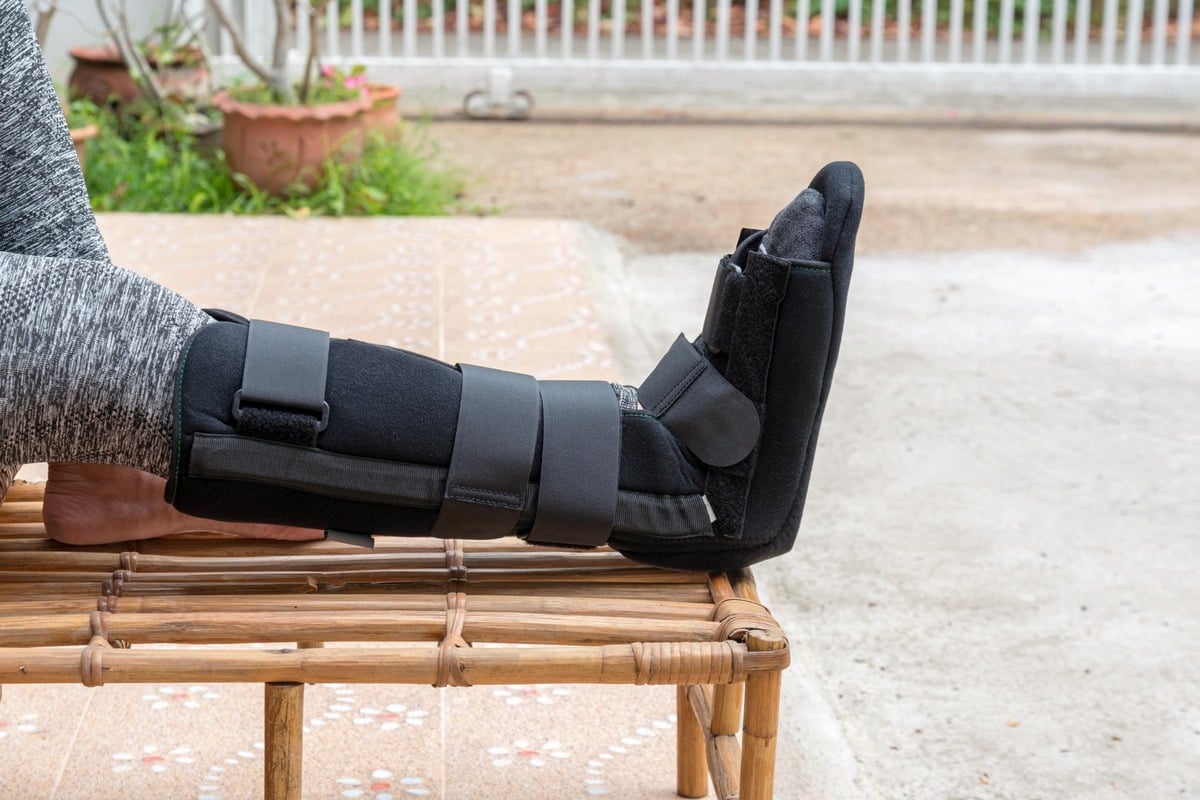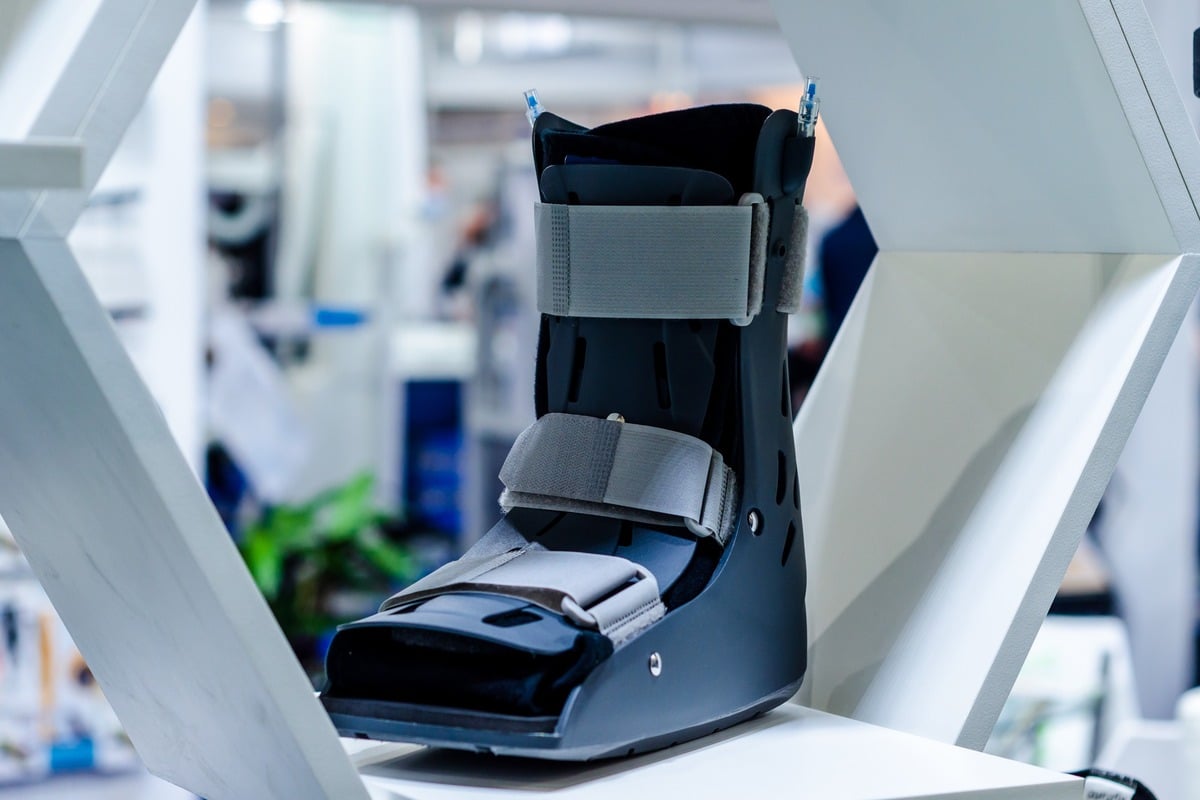How to sleep well with an orthopaedic boot? Tips and tricks for a good night’s sleep
When an injury or surgical procedure such as a fracture or sprain requires the use of an orthopedic boot, it can be difficult for patients to adapt to their new equipment and maintain their usual quality of life. Orthopedic boots are designed to provide support, stability and immobilization of the ankle, foot and calf, but this can lead to discomfort and sleep disruption. Patients may have difficulty finding a comfortable sleeping position due to the size and shape of the orthopedic boot, which can lead to sleep problems such as insomnia and daytime fatigue. It’s important for patients wearing an orthopedic boot to take steps to improve their sleep to aid recovery. This may involve behavioral changes, such as adapting sleeping positions and using supportive pillows, as well as adjusting the boot itself. Patients may also benefit from the use of medication to help improve their sleep. In this article, discover the best practices for sleeping comfortably with an orthopedic boot, taking into account factors such as boot size and shape, recommended sleep positions, support pillows, medications, as well as other practical tips for improving sleep quality. By following these tips, chances are you’ll be able to sleep more comfortably while promoting rapid healing and recovery…
Prepare your bed for a comfortable, restful night’s rest
The night can be difficult and uncomfortable when you have to sleep with an orthopedic boot. But with proper preparation of your bed, you can create a comfortable sleeping environment to help you get a good night’s rest. First of all, it’s important to choose the right mattress. Opt for a medium to firm density mattress to ensure adequate support for your back and lower limbs. If you need more support, you can also use a body pillow or memory foam pillow to help distribute pressure over the whole body.
Make sure your sheets are soft and comfortable, too. Lightweight, breathable cotton sheets are ideal for helping to regulate body temperature during the night. Also make sure that sheets fit snugly and don’t wrinkle under your orthopedic boot. It’s essential to maintain good sleep hygiene by regularly changing your sheets and washing them in hot water to eliminate bacteria and dust mites that can build up.
Don’t neglect the ambience of your bedroom. Make sure your bedroom is dark, cool and quiet to promote restful sleep. Avoid bright lights and loud sounds, using blackout curtains and earplugs if necessary.
By following these simple steps, you can prepare your bed for a comfortable, restorative night’s sleep, even with an orthopedic boot. With the right sleeping environment, you can wake up refreshed and ready to face a new day.
Find the right positioning for sleeping with an orthopedic boot

Now that your bed is ready for you, it’s time to discuss the right positioning for sleeping with an orthopedic boot. Your body position can make all the difference to the quality of your sleep and the healing of your injury. Everyone is different, and the positioning that works for one person may not be right for another. However, there are some basic tips you can follow.
For example, it’s important to keep your injured foot elevated while you sleep. This will help reduce swelling and pain. You can use pillows to support your foot and leg, making sure they are high enough to keep your foot above the level of your heart.
Next, you need to find a comfortable position for the rest of your body. If you’re a stomach sleeper, you may need to change your sleeping habits while you recover. This position can put excessive pressure on your injured foot and affect the quality of your sleep. The recommended position is to sleep on your back, with a pillow to support your head and neck.
However, if you find this position uncomfortable, you can try sleeping on the opposite side of your injured foot. Make sure your injured leg remains elevated and that you use a pillow to support your head and neck. You can also use a body pillow to reduce the strain on your spine and enable you to sleep more comfortably.
Alternatively, if you have difficulty finding a comfortable position, you may consider using a memory foam mattress or mattress topper to reduce the pressure on your body. These options can help reduce pressure points and distribute your body weight more evenly, which can be particularly beneficial if you have pain or pressure points in other parts of your body.
Dress comfortably for the night
Once you’ve found the right position for sleeping with your orthopedic boot, it’s time to focus on your nightwear. Your choice of clothing can have a significant impact on the quality of your sleep. For a start, avoid wearing clothes that are too tight or that compress you, especially in the area affected by the boot. Loose, breathable clothing is preferable, as it will help you feel comfortable and not confined during the night.
If you tend to feel cold at night, consider adding an extra blanket or thicker comforter to keep warm. It’s also important to regulate the temperature in your bedroom so that it’s comfortable for you.
When it comes to socks, make sure they’re not too tight or create pressure on your foot, which could aggravate your pain. Breathable cotton socks are a good choice for sleeping with an orthopedic boot.
For women, it’s important to find the most comfortable bra for sleeping. Wireless bras or sports bras can offer adequate support while being more comfortable to sleep in.
Use a quality orthopaedic boot
When it comes to sleeping with an orthopedic boot, it’ s crucial to choose a quality boot to ensure adequate support and correct foot position without risk. Quality boots are often prescribed by an orthopedic specialist for long-term use. This is because orthopedic boots help relieve pain, reduce inflammation and promote healing. Therefore, investing in a quality orthopedic boot is a wise choice to improve your comfort and quality of sleep.
When choosing an orthopedic boot, make sure it is of superior quality and adapted to your specific needs. A quality orthopedic boot is made from durable, comfortable materials such as neoprene, which offers firm support and a personalized fit. In addition, it’s important to choose an orthopedic boot specifically designed for your type of injury or condition, to ensure proper foot alignment.
When wearing an orthopedic boot, be sure to follow your orthopedic specialist’s instructions for proper positioning. Proper positioning of the orthopedic boot can improve the quality of your sleep by reducing pain and improving blood circulation. It’s also essential to wear a quality boot to avoid skin irritation and rashes.
Avoid moving around too much at night
If you suffer from a foot injury requiring an orthopedic boot for the night, it can be difficult to sleep comfortably while avoiding moving around too much. However, there are tricks you can use to reduce involuntary movements and sleep peacefully through the night. One of the first things you can do is find a comfortable sleeping position. If you’re using an orthopedic boot, it’s important to leave enough space for your foot, while ensuring good support and position. You can also use pillows to support body parts not covered by the boot, such as your leg or back.
Speaking of positioning, it’s important to note that the use of a quality orthopedic boot is essential for good foot support and reduced movement during the night. Make sure you have a properly fitted orthopedic boot, and consult an orthopedic professional if you have any doubts or questions. It’s also important to note that the quality of the orthopedic boot can have an impact on your sleep, so don’t skimp on quality.
Another technique you can use to avoid moving around too much at night is to limit your fluid intake before bedtime. If you need to go to the bathroom during the night, this can disrupt your sleep and increase involuntary movements. Try to drink fewer fluids in the hours before bedtime, and make sure you go to the toilet just before.
Note, too, that orthoptics can be helpful in reducing involuntary movements during the night. Orthoptic exercises can help strengthen your foot muscles, improve balance and coordination, and reduce involuntary movements during sleep. Consult your healthcare professional to learn more about orthoptic exercises that could benefit your situation.
Consult an orthoptic specialist for persistent night-time discomfort

If you suffer from an ankle injury such as a sprain, or another condition that requires you to wear an orthopedic boot, it’s essential to take precautions to ensure comfortable, restful sleep. Of course, there are a number of steps you can take to prepare your bed, find a comfortable sleeping position and choose appropriate sleepwear. However, despite all these precautions, you may still experience pain or discomfort at night. If this happens, it’s important to consult a doctor.
An orthoptic professional is an expert in ankle and foot health care. He or she will be able to assess your situation and give you recommendations on what to do to reduce pain and discomfort. In addition to giving you advice on how to improve your sleep, this orthoptic specialist can recommend exercises and treatments to speed up your recovery.
What’s more, if you notice symptoms such as intense pain, numbness, tingling or excessive swelling, don’t stay in this situation and consult an orthoptic professional immediately. These symptoms could indicate a complication of your condition that requires immediate medical intervention.
In conclusion, it’s essential to take good care of your body, especially when health problems such as an ankle injury require you to wear an orthopedic boot. Getting a good night’s sleep is a key part of this healing process, and by following these tips, you can significantly improve the quality of your sleep. By using a quality orthopedic boot, adopting the correct sleeping position and wearing comfortable clothing, you can avoid the pain and discomfort associated with a restless night’s sleep. Avoiding excessive movement during the night, and consulting your doctor in the event of persistent pain, can help you heal quickly and effectively. If you’ve found this article useful and informative, please feel free to share your own tips and experiences in the comments below! Because, without a doubt, you too can help others sleep better and heal faster…
